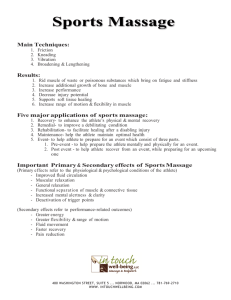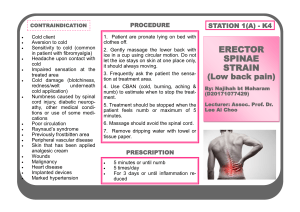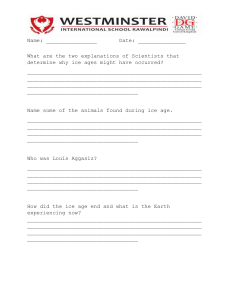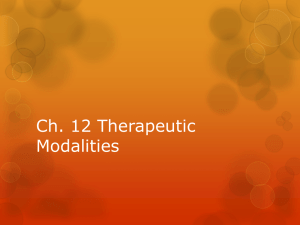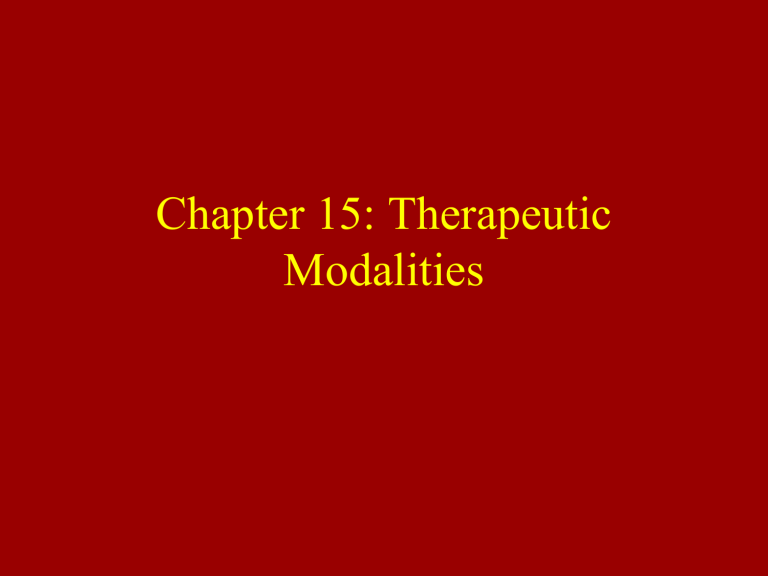
Chapter 15: Therapeutic Modalities • Read Use of Modalities/Choosing a Modality/Methods of Heat Transfer (pgs 22-3 to 22-4) • Therapeutic modalities can be an effective addition to various techniques of therapeutic exercise. Legal Concerns • Modalities must be used w/ great care and should not involve indiscriminate use. • Modality usage varies greatly state to state – ATC’s must follow guidelines established by their individual state. • ATC’s must have knowledge concerning function, indication and contraindications for each modality. • Selection of a modality should be based on an accurate evaluation. Transmission of Thermal Energy • Conduction – Heat is transferred from a warmer object to a cooler one – Dependent on temperature and exposure time – Temperatures of 116.6o F will cause tissue damage and temperatures of 113o F should not be in contact w/ the skin longer than 30 minutes – Examples include moist hot packs, paraffin, ice packs and cold packs • Convection – Transfer of heat through movement of fluids or gases – Temperature, speed of movement, and conductivity of part impact heating – Whirlpools • Radiation – Heating is transferred from one object through space to another object – Shortwave diathermy, infrared heating and ultraviolet therapy • Conversion – Generation of heat from another object (sound, electricity or chemical agents) Cryotherapy • Used in first aid treatment of trauma to the musculoskeletal system • When applied intermittently w/ compression, rest and elevation it reduces many adverse conditions related to inflammation. • RICE (rest, ice compression, elevation) may be used for the initial days of and injury and lasting up to 2 weeks after injury. • Most common means of cold therapy are ice packs and ice immersion Phases of Sensation 1. A cold sensation lasting 0-3 minutes. 2. Mild burning and aching lasting 2-7 minutes. 3. Relative numbness lasting 5-12 minutes. • Physiological Principles – Vasoconstriction – Decreases extent of hypoxic injury to cells-• Decreases cell metabolic rate and the need for oxygen through circulation, resulting in less tissue damage – Decreased metabolic rate and vasoconstriction decreases swelling associated w/ inflammatory response – Decreases muscle spasm – Cold is more penetrating than heat. Guidelines for Cryotherapy • Except for ice massage, use a barrier such as a towel to protect skin form frostbite. • Never apply any form of cold on an open wound without a protective covering. • Never apply any form of cold to anesthetized skin. • Except for vapo-coolant sprays, do not apply cryotherapy to patients with decreased circulation, diabetes, or cardiac conditions. • Some individuals are allergic to cold and react w/ hives and joint pain Guidelines Cont. • Montior the patients for signs of cold allergy, or Raynaud’s Phenomenon (pg 226) • Applications should not exceed 30 minutes! Cryotherapy Techniques • Ice Massage – Equipment • Foam cup with frozen water - creating a cylinder of ice (towel will be required to absorb water) – Indications • Used over small muscle areas (tendons, belly of muscle, bursa, trigger points) – Application • Ice is rubbed over skin in overlapping circles (10-15 cm diameters) for 5-10 minutes • Athlete should experience sensations of cold, burning, aching, & numbness --when analgesia is reached athlete can engage in rehab activities – Special considerations • Keep in mind comfort of the athlete during treatment • Cold or Ice Water Immersion (pg 22-10) – Equipment • Variety of basins or containers can be used, small whirlpool • Temperature should be 50-60 degrees F – Indications • Circumferential cooling a body part – Application • Athlete immerse body part in water through the stages of cold response • Treatment may last 10-15 minutes • Once numb body part can be removed from immersion, ROM exercise can be performed • As pain returns re-immersion should take place • Cycle can be repeated 3 times • Cold or Ice Water Immersion (continued) – Special Considerations • Cold treatment makes collagen brittle -- must be cautious with return to activity following icing • Be aware of allergic reactions and overcooling • Ice Packs (Bags) (pg 22-7) – Equipment • Wet ice (flaked ice in wet towel) • Crushed or chipped ice in self sealing bag – Not as efficient, but less messy – Useful for approximately 15-20 minutes – Towel should be placed between skin and pack • Chemical Cold packs – Gel pack – Liquid pack – Indications • Athlete experiences stages of cooling and then proceeds with ROM exercises – Special Considerations • Avoid excessive cold exposure; w/ any indication of allergy or abnormal pain, treatment should be stopped • Vasocoolant Sprays – Equipment • Fluori-methane, non-flammable substance that is released in fine spray from pressurized canister – Indications • Reduces muscle spasm, increases ROM, effective on trigger point – Application • For spasm and ROM – Hold can 12-18 inches from skin, treat entire length of muscle - covering an area 4 inches/second – Apply spray 2-3 times, while gradually applying a stretch Thermotherapy • Physiological Effects of Heat – Dependent on type of heat energy applied, intensity of energy, duration of exposure and tissue response – Heat must be absorbed to increase molecular activity – Desired effects • decreasing joint stiffness; reducing pain; relieving muscle spasm; reduction of edema and swelling; increasing blood flow • Special Consideration w/ Superficial Heat – Important contraindications • Never apply heat when there is loss of sensation • Never apply heat immediately after injury • Never apply heat when there is decreased arterial circulation • Never apply heat directly to eyes or the genitals • Never heat the abdomen during pregnancy • Never apply heat to a body part that exhibits signs of acute inflammation – Moist Heat Therapies • Difficult to control therapeutic effects primarily as a result of rapid dissipation of heat which makes it difficult to maintain a constant temperature • Superficial tissue is a poor thermal conductor temperature rises quickly on the surface compared w/ underlying tissue (deep tissue experiences little rise in temperature) • Moist Heat Packs (pg 22-16) – Equipment • Silicate gel pads submersed in 160-170o F water • Maintains heat for 20-30 minutes; must use 6 layers of terry cloth to protect skin – Indications • Used for general muscle relaxation and reduction of pain-spasm-ischemia-hypoxia-pain cycle • Limitation - unable to heat deeper tissues effectively – Application • Pack removed from water; covered w/ 6 layers of toweling which are removed as cooling occurs; area treated for 15-20 minutes • Athlete must be comfortable and should not lay on pack • Whirlpool Bath (pg 22-12) – Equipment • Varying sizes used to treat a variety of body parts • Tank w/ turbine that regulates flow • Agitation (amount of movement) is controlled by air emitted – Indications • Combination of massage and water immersion • Provides conduction and convection • Swelling, muscle spasm and pain – Application • Temperature is set according to treatment goals – Do not place directly on injured site • Maximum treatment time for acute injuries should not exceed 20 minutes • Special Considerations – Must be careful with full-body immersion – Proper maintenance is necessary to avoid infection – Safety is a major concern • Electrical outlets • Athlete should not turn whirlpool on or off • ***************** • Paraffin Bath (pg 22-18) – Equipment • A paraffin wax and mineral oil combination, heated to 126-130o F, plastic bags, paper towels and towels – Indications • Useful in treating chronic injuries • Effective for angular areas of body such as hands, wrists, elbows, ankles and feet – Application • Body part is cleaned and dried • Dip and wrap technique – Hand dipped 6-12 times, wrapped in a plastic bag and then draped w/ a towel to maintain heat for 30 minutes • Soak technique – Body part remains in wax 20-30 minutes w/out moving it • Contrast Bath (pg 22-13) – Equipment • Requires use of hot and cold tubs/whirlpools – Indications • Used when changing treatment modality from cold to heat -- allows for transitional period when introducing mild tissue temperature increase • Minimal temperature changes occur superficially • Does not produce pumping action through vasomechanics – Application • Treatment ratio used (move from primarily cold to heat) • Water temperature should be kept constant and athlete should be comfortable • Fluidotherapy (pg 22-16) – Equipment • Unit which contains cellulose particles through which warm air is circulated (dry whirlpool!) • Allows for high heating (higher than water and paraffin) – Indications • Used to treat distal extremities in effort to decrease pain, increase ROM and decrease swelling and spasm – Application • • • • • Temperature ranges from 100-113o F Particle agitation should be controlled for comfort Athlete should be comfortable Treatment time = 15-20 minutes Exercise can be performed while in cabinet Ultrasound • Modality which stimulates repair of soft tissue and pain relief • Form of acoustic energy used for deep tissue heating – Operates at inaudible frequency – Sound scatters and is absorbed as it penetrates tissues -- losing energy = attenuation – Impedance and penetration are determined by properties of media (densities) – Intensity is determined by amount of energy delivered to the sound head (W/cm2) – Can be delivered as either pulsed or continuous ultrasound • Indications – Produces thermal and non-thermal effects • Generally used for tissue heating (must increase tissue temp between 104o and 113oF – Acute conditions require more treatments over a shorter period and chronic conditions require fewer treatments over a longer period – Dosage and Time • Varies according to depth of tissue to be treated and the state of injury • Duration tends to last 5-10 minutes – Special Considerations • While it is a relatively safe modality, precautions still must be taken • Be careful with anesthetized areas, reduced circulation • Avoid high fluid regions of the body, acute injuries, and epiphyseal areas of children Guidelines for Electrical Modalities • • • • • Follow MDs order. Make sure equipment is in working order. Explain the procedure to the client. Expose the area to be treated. Cleanse the treatment area with soap and water and dry. • Place electrode pads according to the manuf. Directions. • Turn off the channel before you remove the electrodes. Cont. • Never use on an open wound. • Do not use on a person with a pacemaker without MD order. • Avoid high fluid areas. • Do not put over carotid arteries. • Do not use on trunk of a pregnant women. • Stop the treatment if it increases pain. Phonophoresis • Method of driving molecules through the skin using mechanical vibration – Process which moves medication to injured tissues – Primarily used to drive hydrocortisone and anesthetics into the tissue – Used on trigger points, tendinitis and bursitis – Effectiveness of treatments is still being explored – Generally involves the use of a 10% hydrocortisone ointment, which rubbed into the area; followed by application of coupling medium and ultrasound treatment – Chem pads, impregnated with medication is also being explored • Electrotherapy • Electrical Stimulating Units – Three types of units • TENS - transcutaneous electrical nerve stimulators • NMES/EMS - neuromuscular electrical stimulators or electrical muscle stimulators • MENS/LIS - microcurrent electrical nerve stimulators or low-intensity stimulators EMS • Used to re-educate injured or impaired muscles, slow the effects of atrophy, and increase the strength of healthy muscles through electrical stimulation. The pads are placed on the skin at both ends of the muscle. Wires are attached to the pads and to the control unit. TENS • Used to block the sensation of chronic or acute pain. Often, a 30-minute to one-hour application will relieve pain for hours after the treatment. The use of TENS will allow the patient to perform therapeutic exercise without pain. Diathermy • Uses high frequency electrical current to heat the body’s tissue. It will increase the blood flow and tissue metabolism. It also decreases deep muscle spasms. It is used for chronic strains, sprains, limited ROM, sub-acute inflammations (bursitis, epicondylitis, tendonitis, arthritis). • Avoid growth plates, open wounds, malignancy, and areas with limited circulation. • Ionotophoresis – Chemical ions are transported through intact skin using electrical current -- used to treat skin infections or to produce a counterirritant effect – Pads and wires are used to connect the patient to the machine. One pad delivers the medication and the other pad serves as a ground – Can be used for superficial tendonitis and bursititis to decrease edema, inflammation and pain. Massage Strokes • Effleurage – Stroking divided into light and deep – Can be used as a sedative or to move fluids – Multiple stroking variations exist – Pressure variations Stroking Variations Petrissage • Petrissage – Kneading – Involves picking up skin between thumb and forefinger, rolling and twisting in opposite directions – Used for deep tissue work • Friction – Used around joints and in areas where tissue is thin – Areas w/ underlying scarring, adhesions, spasms and fascia – Goal is to stretch underlying tissue, develop friction and increase circulation • Guidelines for an Effective Massage – Make the athlete comfortable • Positioning, padding, temperature, privacy – Develop confident, gentle approach to massage • Good body positioning (clinician and athlete) an develop good technique – Stroke towards heart to enhance lymphatic and venous drainage – Know when to avoid massage • Acute conditions, skin conditions, areas where clots can become dislodged • Sports Massage – Usually confined to a specific area - rarely given to full body – Full body massage is time consuming, generally not feasible – Five minute treatment can be effective – Massage lubricants • Enables hands to slide and move easily over body, reducing friction • Rubbing dry area can irritate skin • Mediums include powder, lotion, oil or liniments – Positioning of Athlete • Area must be easily accessible and must be relaxed – Exhibit Confidence
